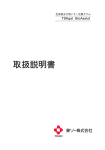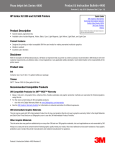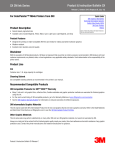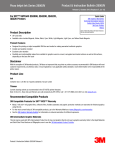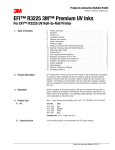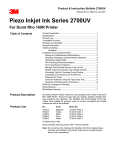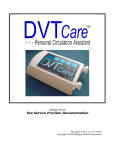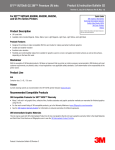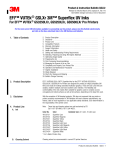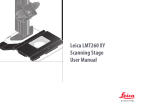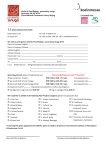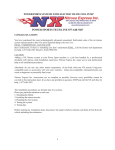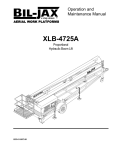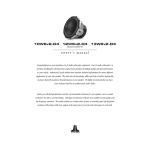Download European Product Bulletin - Graphic Protection Options
Transcript
3M Europe, Effective June 2015 Piezo Inkjet Ink Series 1500v2 For EFI™ VUTEk® 150, 2360/3360, 3000/5000 and 3300/5300 Printers Product Bulletin Product Description Product Line Compatible Products Flammability Durability Setting and Understanding Printing Requirements Ink series 1500v2, when used with 3M films and sign facings, makes attractive four, six or eight color graphics. These solvent-based, pigmented inks, which are weather resistant and have excellent color retention, are designed and approved for use in the EFI™ VUTEk® 150, 2360/3360, 3000/5000 and 3300/5300 Printers. Ink No. Color 1581v2 Light Magenta 1582v2 Light Yellow 1585v2 Light Black 1586v2 Light Cyan 1591v2 Magenta 1592v2 Yellow 1595v2 Black 1596v2 Cyan Container size: 1 gallon (3.8 liter) Thinner 3M™ Thinner CGS-15 3M Graphic Materials For complete details about graphic construction options, recommended uses and durability, refer to the Product Bulletin for the base film or substrate (media) you are using. For further details, please contact your local 3M representative. Flammabiltiy standards are different from country to country. Ask your local 3M contact for details, please. For complete details on recommended applications, graphic construction options, durability and warranty, please refer to the base film’s Product Bulletin. Printer operator The printer operator needs to understand the relationship between film characteristics, printer setup, total ink coverage and drying to produce graphics that achieve the performance expectations of the film and the customer. Graphic designer The graphic designer needs to know the parameters and printing recommendations for both the film and printer being used for each graphic. Graphic applicator The graphic applicator needs to be aware of any special handling or application techniques for the construction. Any combination of high total in coverages, hot application temperatures and irregular application surfaces may make the application more difficult. Some application difficulties cannot be controlled by the film processing. Refer to the Product Bulletin for application details on each product used in the construction. 3M Europe Product Bulletin 1500v2 page 1 of 6 Selecting, Preparing and Using 3M Graphic Materials Each film has specific intended uses, contruction options, processing conditions, and durabilities. Always refer to the Product Bulletin for each of the materials and to the recommended Instruction Bulletins for complete details. Visit the web site of your local subsidary at www.3Mgraphics.com for getting more information. Do not use damaged rolls of film, which can result in head strikes and printer damage. Condition the film, ink and graphic protection for 24 hours in the same environment as the printer before using. Optimizing Image Quality Good color management practices are essential. For good color output the graphic designer must consider the printer, the halftoning method and the ink series being used. Use the method you are accustomed to that provides the desired printing results, which may include Photoshop®, files from high end scanners, or ICC profiles made for proper color management. Use the correct software profiles. Each printer, ink and material combination has a unique printer profile that helps ensure succesful printing. Contact the printer manufacturer for assistance. Film Processing Recommendations Printer Settings 2360/3360 Printers with IR Heaters 150/2360/3360 Printers without IR Heaters All Printers The most commonly recommended printer setting is “Ultra Standard” because of its image quality. Ultra Standard provides a good balance of high image quality and productive output. Run the pre-heat temperature 24 °C to 49 °C so you get sufficient dot gain. These settings provide a good starting point. Follow VUTEk User’s Guide for printer adjustments to achieve optimum output. Starting Point Typical Range Pre-heat 30 °C 24 – 45 °C Post-heat 40 °C 30 – 55 °C IR heater 55 °C 50 – 65 °C Pre-heat 40 °C 30 – 50 °C Post-heat 60 °C 55 – 71 °C Adjust the vacuum for optimum test 1 jetting. The setiting is tpypically -0.24 - -0.29 psi for ink series 1500v2. Weep cycles will help maintain open jets when not printing. The recommended settings are: Weep interval 4 sec Week count 20 Spittoon count 1 Solvent Ink Printing Effect on Printed Images Effect When Using a UV Clear 3M Europe Normally, very small amounts of retained solvent will not affect the finished graphic characteristics or application performance. Excessive solvent must be removed through proper drying prior to applying graphic protection (overlaminate or clear). If it is not, the graphic protection will trap excessive retained solvents. This softens the film and allows the solvent to migrate into the adhesive. Softened film is more likely to stretch, curl, bubble, lift off liner, pucker, or shrink when handling and during graphic application. In addition, the solvent in the adhesive will contribute to more aggressive adhesion. The result is poor application characteristics. Important drying details are included later in this bulletin. If a UV clear coat is used and excessive solvent remains in the film, the surface may blister while curing the clear. Product Bulletin 1500v2 page 2 of 6 Managing Total Physical Amount of Ink on Film Properly managing the total amount of ink laid down in any area on the graphic results in better image quality, less ink usage, faster drying and greater throughput. It also helps ensure good film performance. The maximum Total Ink Coverage for each recommended 3M film is in that film's Product Bulletin. Total ink coverage is the total percentage of all inks (CMYK) used in the graphic. For example, CMYK values of 60%, 60%, 60% and 100% produces a total ink coverage of 280%. Note: Depending on the software you are using or the color printing reference books you use, total ink coverage may be called: total area coverage, total dot area, max CMYK, maximum ink amount, total ink limit, total printing dot. There is a common misconception that because the ratio of ink solids to solvent is very low, the only way to achieve satisfactory density is to use high ink coverage. Testing shows that in many cases you can achieve very good density with lower total ink coverage with little or no loss of quality. The rest of this section discusses options for managing the total ink coverage. Setting Total Ink Coverage in Original Artwork The best time to affect total ink limits is when the original artwork is created. Have the artist or graphic designer observe two simple rules while creating the artwork to greatly simplify printing. 1. Do not exceed the maximum Total Ink Coverage for the film you are using, which is specified in the film's Product Bulletin. 2. The graphic designer should always specify and supply the proper ICC color profile for the film, ink and printer system when submitting the artwork for printing. Correcting Total Ink Coverage During Printing Ink Usage Factors 3M Europe Achieving proper ink coverage during printing is generally a three step process; clip the upper ink limits, calibrate or linearize the output and use a good color profile during the RIP process. 1. Determine the maximum ink necessary to produce the greatest color saturation. For example, if you print and review a series of color patches in 1% increments from 90% to 100%, you may notice no visible difference between the 96% and the 97% patch. Therefore, any ink used above 96% will not create a more saturated color. However, use of ink above the 96% amount unnecessarily adds additional ink that does not contribute to or improve the image quality. 2. Properly calibrate or linearize your film, ink and printer system. A properly calibrated or linearized print system will use just the right amount of ink to reproduce the highlight, mid and shadow tones called for in the digital image. 3. Use the proper combination of source and destination color profiles to print your graphic. Preferably, the artist or graphic designer should supply the source color profile used to create the digital artwork. Applying the proper destination or printer color profile for your particular film, ink and printer system will ensure the total ink limit is not exceeded. 4. If the total ink coverage is still too high, your RIP software probably supports ink limiting. You may be able to use this function to reduce the total amount of ink on the film. Note: For complete details on ink control, refer to the User's Guide for the RIP you are using. Ink usage is affected by several factors: Image tonal value Ink limit parameter Printer linearization file Resolution (DPI) Automatic cleaning cycle Manual nozzle cleaning or purging cycle Printer parameters Product Bulletin 1500v2 page 3 of 6 About Drying Printed Film Completely and Properly Dry Printed Film Use the maximum dryer setting available for your printer that will not distort or damage the film. • Dry the film immediately after printing. In general, use as slow of a speed and as high a temperature as possible without damaging the film and ink. • Run the post-heat (dryer) at 55° to 71°C to dry out as much solvent as possible and facilitate drying. • Additional drying options. - An auxiliary dryer may also be used to complete the drying (2 hours @ 66 °C should be sufficient). - Air drying on racks may be used, although it is less effective than oven drying and takes significantly longer. Graphics printed with a total ink coverage of 300% take 12 to 24 hours of air drying. - Reducing total ink coverage reduces solvents and therefore reduces drying time. • Troubleshooting - Change the temperature or drying times only if you observe problems. - Too much heat in the drying process may result in any of the following. Reduce the heat to correct the problem. • Film problems, including liner blisters and film shrinkage • Transport problems in the printer • Wrinkling when the printed graphic is overlaminated or premasked. - The drying time varies for each film and the total ink coverage its image. - If the film does not seem to be drying adequately, slow down the dryer. • To check dryness, use the Dryness Test, below. Graphic Performance Problems Due to Insufficient Drying Dryness Test for Most Graphics • • • • An overlaminate may be difficult to apply. A UV clear may result in some loss of surface gloss during the UV curing. Image blocking or embossing may occur when the graphic is unrolled prior to application. For Controltac graphic films, the slideability and positionability features will be significantly reduced during application if the film is not sufficiently dried. The dryer times vary with the equipment being used, oven temperature, humidity conditions, etc. Insufficient drying can result in blocking or severe surface impression. Therefore, it is important to check for sufficient dryness when the printing starts. We recommend using the following procedures to determine if adequate drying has occurred. 1. Use this test to set the dryer conditions and approximate dryness. a. Touch a printed sheet face to face. b. Place the touched area close to your ear and separate it. • If the graphic is adequately dried, there is either a slight or no discernible sound when the surfaces separate. • If the graphic is not sufficiently dry, a crackling sound is heard. The louder the sound, the greater the amount of additional drying needed. 2. Even when the graphic feels or appears dry, some solvent will remain. Use this test to determine if minimum drying has taken place. If it does not pass this test, more drying is required. a. Place several printed sheets face-to-face under a 30 cm (12 inch) stack of film or under a weight of 135 g/cm2 (2 pound per square inch) b. After 10 minutes, remove the sheets and check for blocking or surface impressions. If blocking or severe surface impressions are noted, either increase the temperature or decrease the belt speed. 3M Europe Product Bulletin 1500v2 page 4 of 6 Guidelines for Graphics with Heavy Ink Laydown and a UV Clear Coat Ink limiting and/or additional drying may be necessary for an image with heavy ink laydown, if you are applying a UV clear. 1. To test for maximum ink laydown and/or adequate drying, print the film type that you plan to use in production using a range of total ink coverage percentages. Use the proper printer production default settings that are optimum for the film and image you are printing. 2. Apply UV clear to the test images. If the surface blisters during the UV clear curing step, there was excessive retained solvent in the on the film. There should be no loss of surface gloss created during the UV clear curing process. The step test range of ink laydown percentages will tell you at what point blistering starts. To improve: a. Limit the total ink coverage. This is the preferred method to eliminate blistering that occurs during UV clear curing. b. Before applying a clear, dry out the solvent better by running the image through the dryer multiple times, slowing down the dryer belt, increasing the dryer temperature, rack drying over an extended time, etc. Operation and Maintenance Procedures CAUTION Printer cleanliness is very important in the production of high quality, full color graphics. Follow all operation and maintenance procedures recommended in the printer's user manual. Use 3M thinner CGS-15 for performing normal printer maintenance. 3M does not support or authorize the use of any other solvent/cleaner with this 3M ink series. Before handling any chemical products, always read the container label and the MSDS. Shelf Life, Storage and Shipping Shelf Life Storage Conditions Shipping Finished Graphics Shipping Ink Waste Disposal Inks Cloth or Towelling (wipes), Empty Ink Boxes and Bags, Undried Prints Remarks 3M Europe Use within two years of manufacture. A Use By Date, such as 01Apr2008, is located on each ink container. • Store inks in the original container. • 0 °C to 32 °C Refer to the base film's Product Bulletin. This ink is not regulated for shipping. In the United States, the Department of Transportation classifies the inks as non-hazardous. The inks are non-regulated when transported via ground or air. Opened ink containers may no longer provide adequate protection against leaks and spills. Exercise caution when shipping opened containers to ensure prevention of spills or leaks. Waste from the printer includes ink waste, cloth, paper towels and ink boxes and bags. Please handle all waste in a responsible manner. Some general guidelines are provided below. Ink waste must be incinerated in an industrial or commercial facility. Do not pour inks down the drain, or put in the general trash or in a landfil. Since regulations vary, consult your own applicable regulations or authorities before disposal. A 55-gallon drum with a closeable top is recommended for the disposal of waste ink, cloths, undried prints and empty ink boxes and bags. This material should be incinerated in an industrial or commercial facility in accordance with your local requirements. This bulletin provides technical information only. Product Bulletin 1500v2 page 5 of 6 Important Notice Additional Information All questions of warranty and liability relating to this product are governed by the terms and conditions of the sale, subject, where applicable, to the prevailing law. Before using, the user must determine the suitability of the product for its required or intended use, and the user assumes all risk and liability whatsoever in connection therewith. Visit the web site http://www.3Mgraphics.com for getting: - 3 Commercial Graphics Hermeslaan 7 1831 Diegem, Belgium 3M Europe more details about 3M™ MCS™ Warranty and 3M™ Performance Guarantee additional instruction bulletins a complete product overview about materials 3M is offering. Responsible for this technical product bulletin 3M Deutschland GmbH Safety & Graphics Laboratory Carl-Schurz-Str. 1 41453 Neuss, Germany Product Bulletin 1500v2 3M, Controltac, Envision, Panagraphics, Panaflex, Scotchcal, Comply and MCS are trademarks of 3M Company. All other trademarks are the property of their respective owners. The use of trademark signs and brand names in this bulletin is based upon US standards. These standards may vary from country to country outside the USA. page 6 of 6






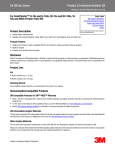
![Stained Light取扱説明書Rev_1_6_ppt [互換モード]](http://vs1.manualzilla.com/store/data/006683971_2-e47b270f9154e8911fccd5923647a777-150x150.png)
